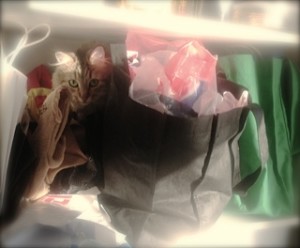Environmental Enrichment of cats part 2
Environmental enrichment isn’t just about making an environment fun and stimulating, it is also about arranging the environment so that the animal can feel comfortable and at ease.
Cats like to have access to places where they can hide away and they like to utilise three-dimensional space.

Many cats enjoy hidey-holes that can either be incorporated into the existing space, such as having some shelving available where the cat can hide behind or among things on the shelf, or buying special cat domes or tents. I have seen a fabulous idea for a hidey-hole on Facebook recently and it was made using an old T-shirt stretched over a cardboard box, with the neck of the T-shirt as the entrance. Another good idea is to leave the cat carrier available with snuggly bedding in it. Cats who have not come to associate their carrier with aversive experiences, such as trips to the veterinarian, can enjoy time in this “cave”.

Cats are quite natural climbers. They can climb quite high up vertical tree trunks and gain an overview of their environment from a branch. A small house or apartment may have a lot more available space to a cat than we ground-dwellers can access. For a cat who lives indoors, this can be a wonderful thing to allow them more space in their home. It is just a matter of us cat owners looking at what space there is and how we can make the high up places safely accessible to our feline friends. We can think about places such as tops of bookshelves, the kitchen fridge, wardrobes, office shelving and laundry shelves as examples of pre-existing high perches that can be made available to cats. Cat condo’s also provide perches as well as scratching sites and hidey-holes for cats. Such equipment can be another option for enriching a cat’s environment.
Scratching is a natural behaviour for a cat and depriving a cat of the opportunity to scratch would mean that you are not meeting their needs appropriately.
Cats that are allowed outside may find scratching sites outside to satisfy their needs. However, scratching not only has the effect of shedding redundant claw sheaths, but it also acts as a visual and scent mark.
Often people wonder why the cat chooses the couch corner for scratching, rather than the cat scratching post in the corner.

The answer is sometimes in the type of substrate (the fabric of the couch) and whether the cat has scratched there before, but the reason can also be the site of the couch in comparison to the scratching pole. Because scratching is a marking behaviour, a cat will want the marks to be in an obvious place where they will be seen and potentially smelled. The height of the scratching post needs to be taken into account. Many posts are too short to offer the cat a chance to stretch the front paws from a comfortable position. If you ever walk your cat outdoors, watch where they choose to scratch on a tree.
Some cats prefer horizontal rather than vertical scratching and many cats prefer a combination of both. If your cat is indoors, scratch mats can give horizontal scratching opportunities.

